If you like Succulents and Cacti, you already know hundreds exist all over the world.

People often think Cacti are unfriendly plants - but this is not true. Cacti can be very low-maintenance, making them perfect for busy homemakers who still want to keep some pet plants. With hundreds of species to choose from, you will be surprised to see their various shapes, colors, and sizes.
Cacti aren’t just famous for growing in deserts. You can grow them in your home, lawns, and backyards too. If you want to learn more about these wonderful, prickly but friendly plants, then you’ve come to the right place.
Sit back and let us tell you about the 133 different types of Cacti!
-
Christmas Cactus

Although we are talking about Cacti, a plant notoriously known for being prickly and haughty, we want to begin our list on a happy, festive note. The first type of cacti we want to talk about is the Christmas Cactus. As its name suggests, this cactus looks bright and happy!
The Christmas Cactus can live for 100 years, well exceeding most human lives. It is an inexpensive and hassle-free plant, making it the perfect companion for busy homeowners who wish to have a plant pet.
-
Fairy Castle Cactus

Can you imagine a cactus looking like a fairy tale castle? Well, this one does - hence its quirky name. These cacti are slow-growing, reaching heights of up to 6 feet over their lifetime. However, they rarely bloom flowers. When they do, the flowers are brightly colored and beautiful to look at.
-
Barrel Cactus

Funnily, this cactus is also known as the ‘mother-in-law cushion.’ Although it doesn’t require much water, it needs plenty of sunlight to survive. Water it just once every 2-3 months, which is enough.
-
Star Cactus

Also known as the sea urchin cactus or starfish cactus, this plant has a large, yellow, or white flower, which is the show-stopper. The plant itself is small and low-maintenance and is, thus, an ideal house plant.
-
Saguaro Cactus
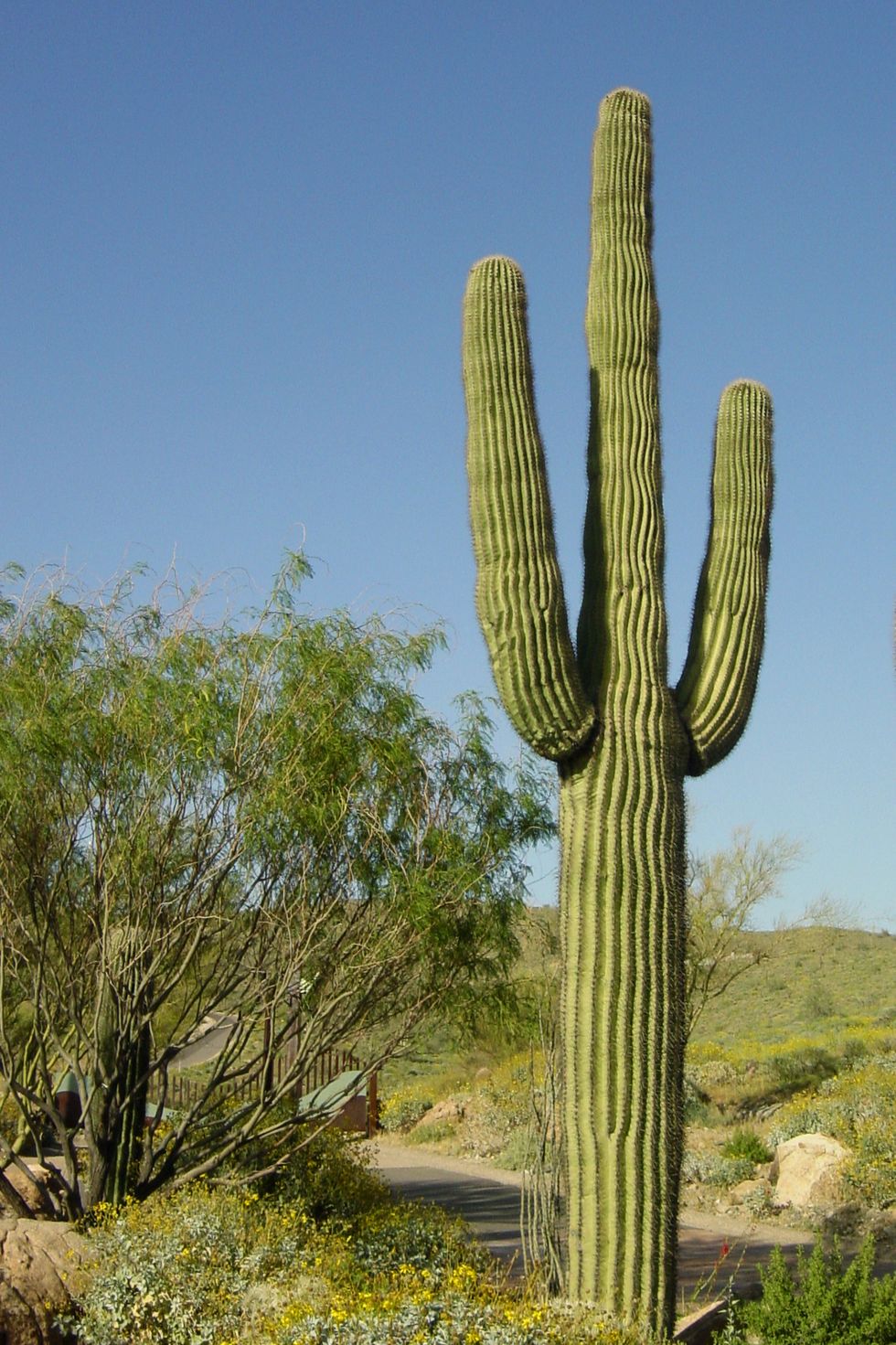
Although the Saguaro Cactus is an outdoor plant, its slow growth rate for the first 8 years of its life allows enthusiasts to grow it indoors. Native to the Sonoran Desert, this cactus can live for 200 years.
-
Feather Cactus
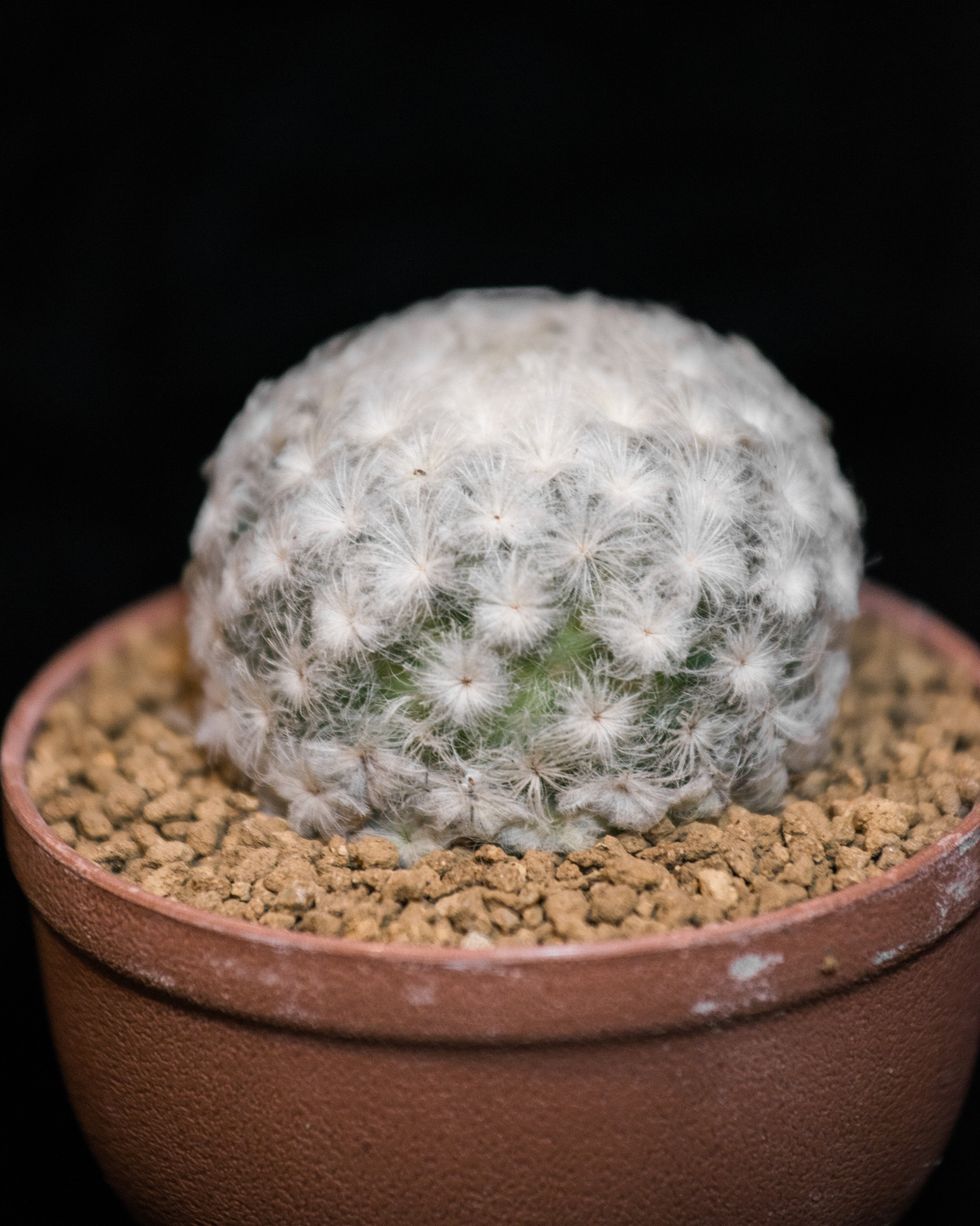
The white ‘feathers’ on this cactus are deceptive. In reality, these ‘feathers’ cover up the sharp spikes covering its body, making it a dangerous little plant. However, its small size makes it an ideal house plant.
-
Bunny Ear Cactus
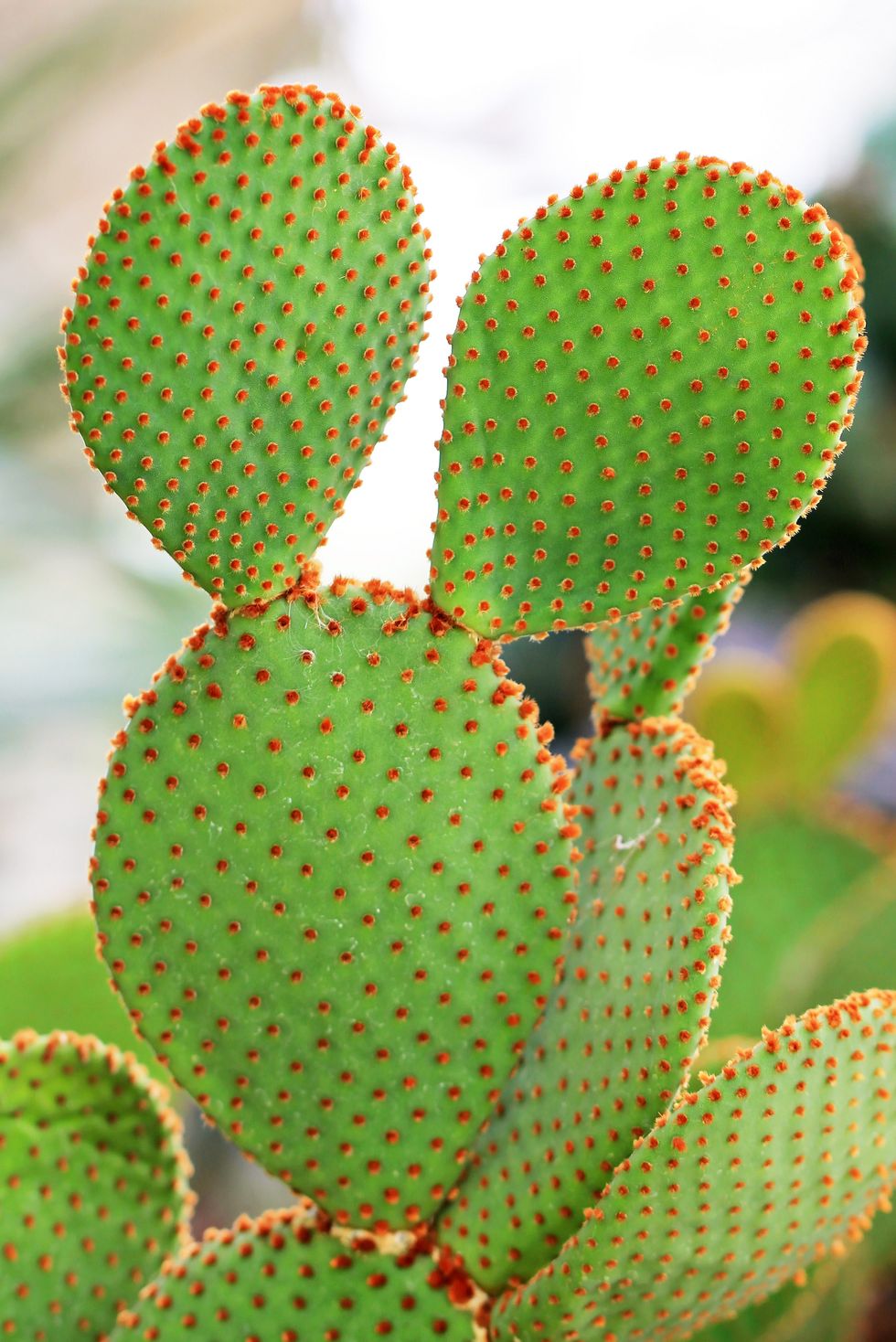
It’s hard to say no to a cactus, which looks as adorable as the Bunny Ear Cactus. Due to its distinctive looks, it’s also called the Angel Wing Cactus and is a popular gifting option. Unlike its siblings, this cactus doesn’t have prickly spines but has glochids (which are still painful to touch).
-
Old Lady Cactus
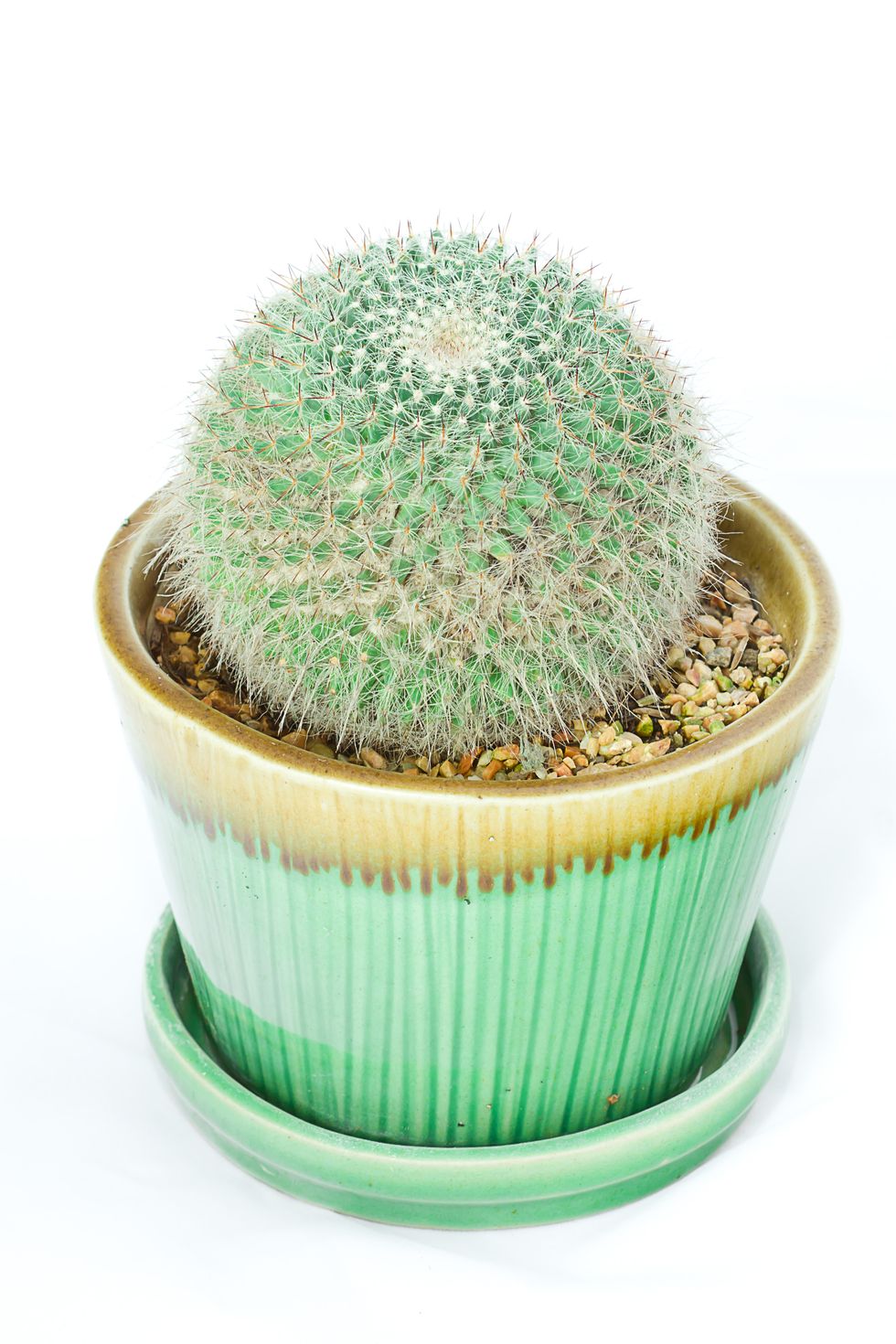
Resembling a powder puff with white spikes, this cactus is a popular choice for beginner plant enthusiasts. Although it looks small and innocuous, its spikes are dangerous to touch.
-
Blue Columnar Cactus
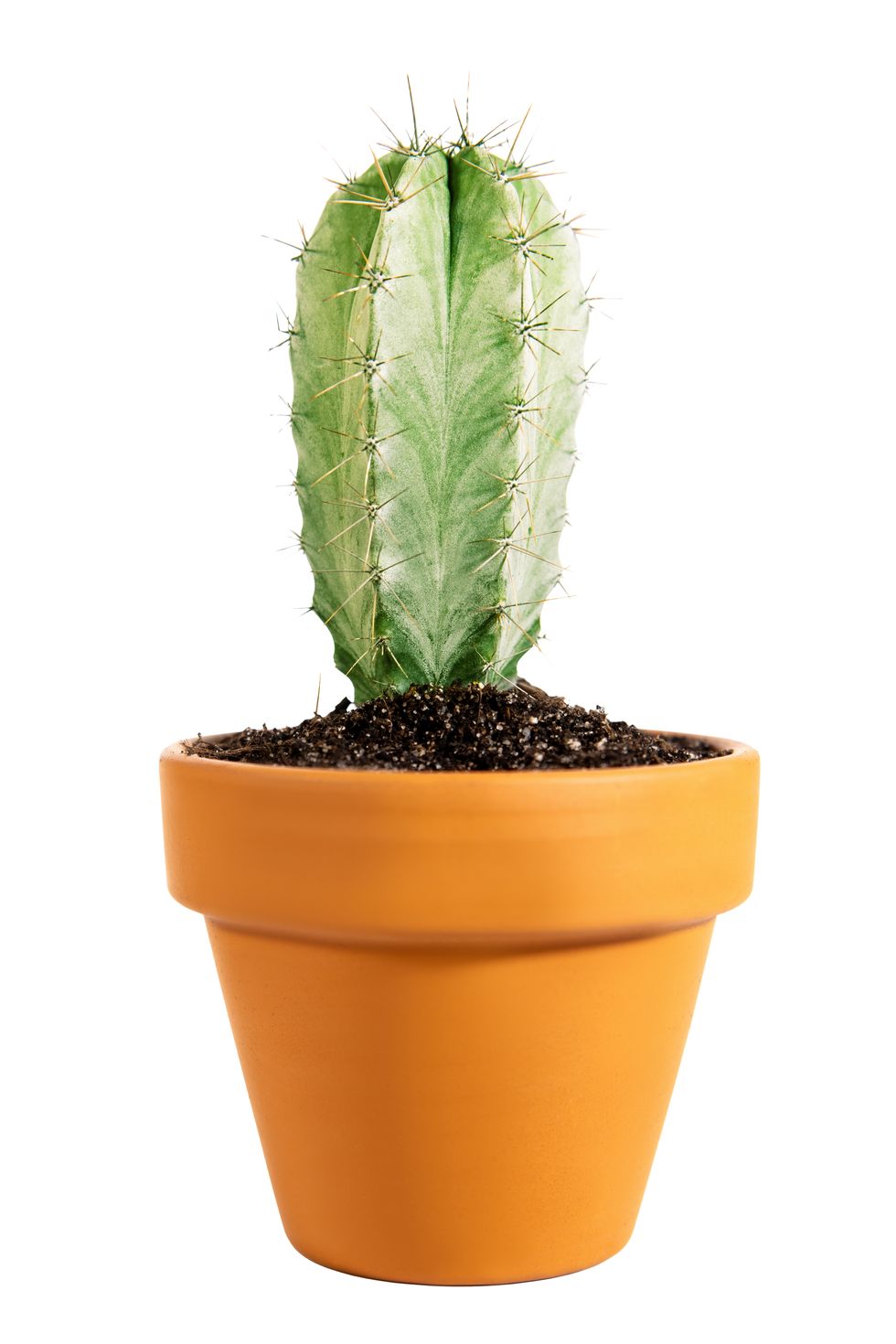
A fast-growing cacti, this plant can reach up to 30 feet in height when fully mature. Its spikes are large and prickly and it has funnel-shaped blooms.
-
Moon Cactus
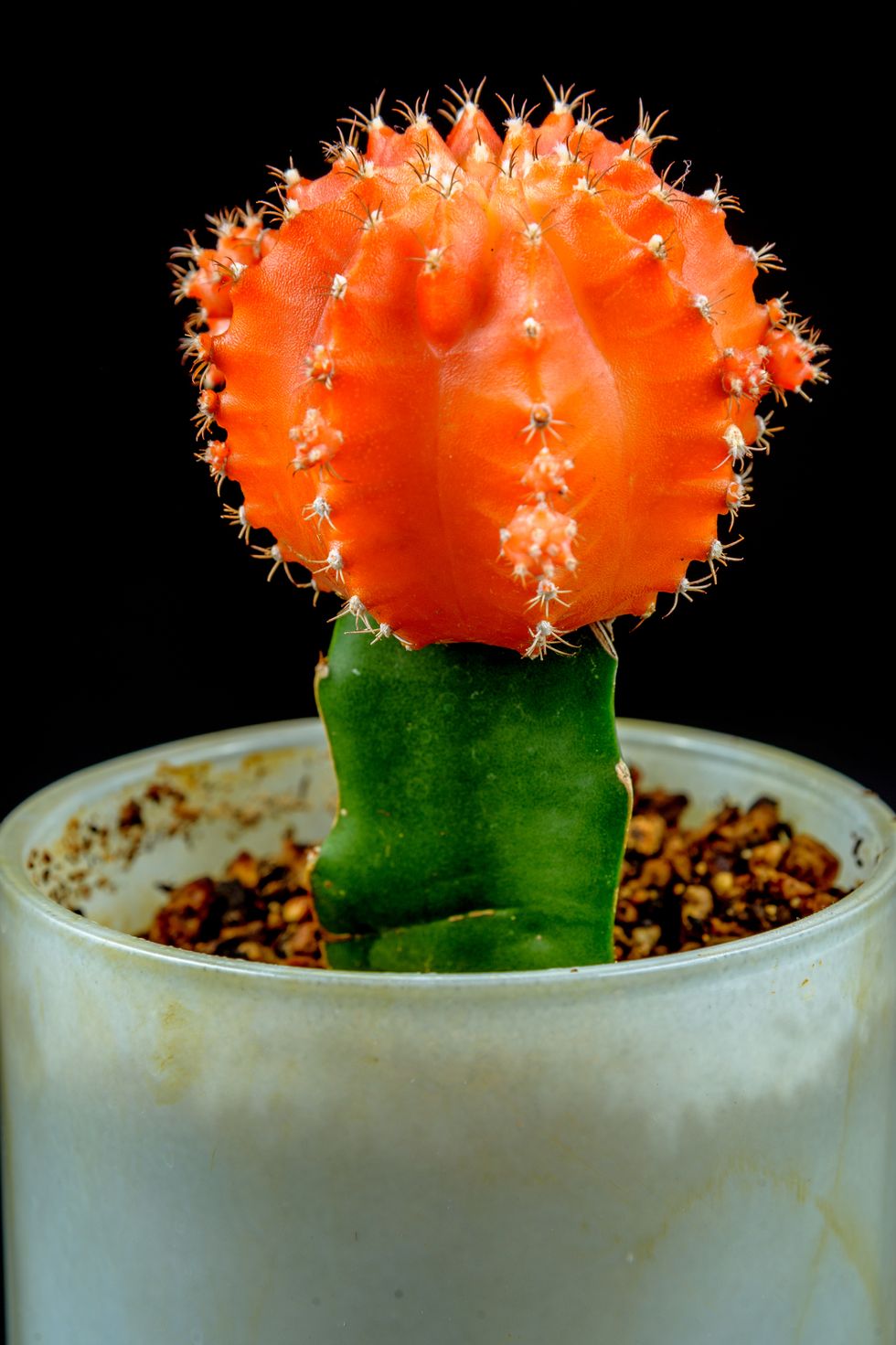
Compared to other species of cacti, the Moon Cactus is short-lived. However, due to its hassle-free nature and beautiful, vivid bloom, it is a popular choice for gifting or to keep as a houseplant.
-
African Milk Tree Cactus
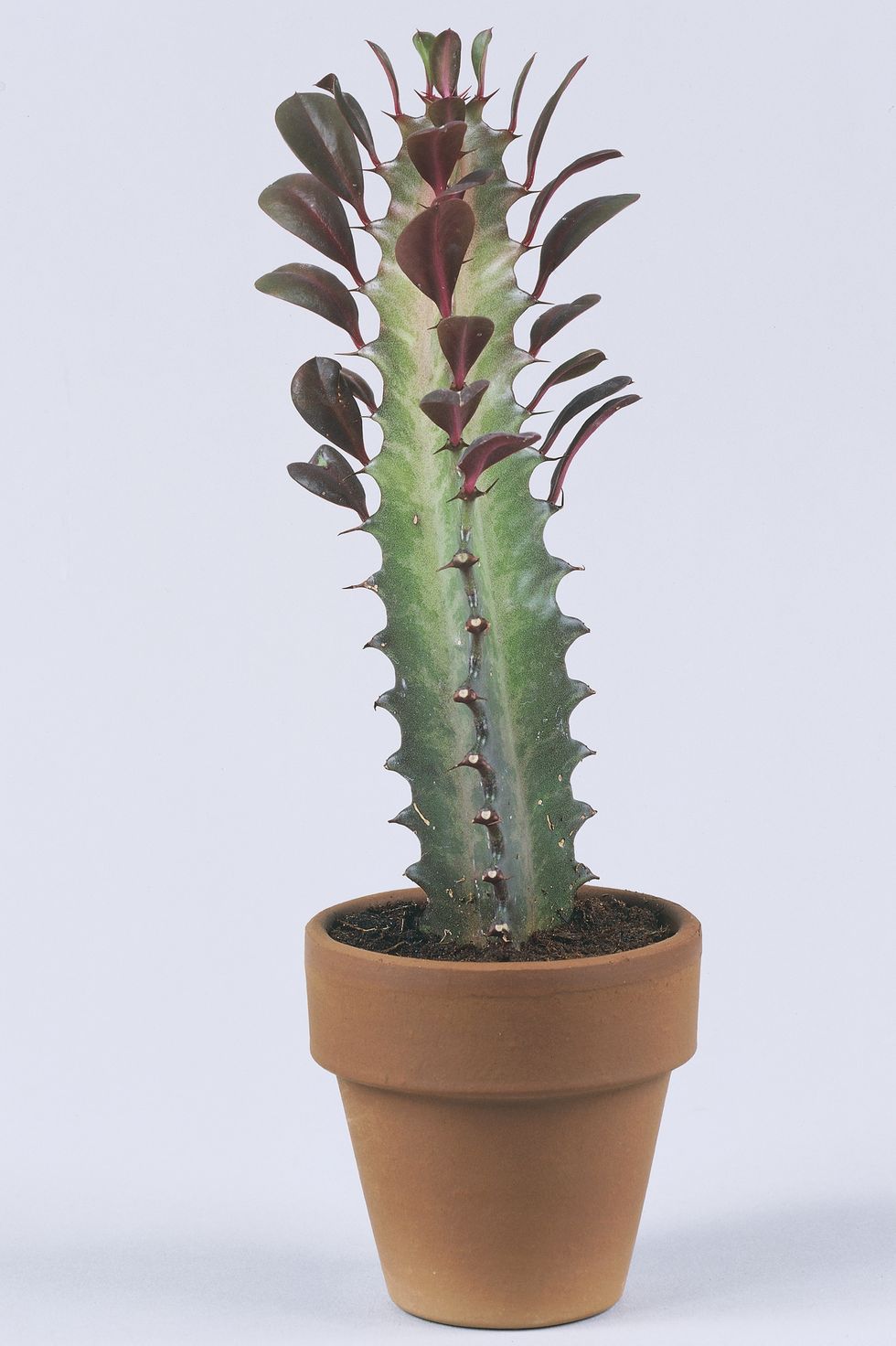
Long, columnar, and sprouting pretty, oval-shaped dark leaves, the African Milk Tree Cactus is technically a succulent. Although it looks aesthetically pleasing, be careful while handling it, as its sap may cause skin irritation.
-
Bishop's Cap Cactus

It’s evident by the name that this cactus is star-shaped, like a Bishop’s cap. It requires very little room to grow, and is low-maintenance, making it a great option to add to your home garden.
-
Parodia

Unlike other cacti of its kind, the Parodia boasts large, brightly colored flowers and requires more water than others. However, this cactus grows best when it’s not kept in direct sunlight for too long.
-
Easter Cactus

This cactus has multiple bright-colored flowers growing all over its body. If well cared for, the cactus can bloom every spring and looks extremely attractive. But, this plant is known to be aesthetically pleasing and a great addition to any home, even without its blooms.
-
Ladyfinger Cactus

This cactus is petite, growing only 6 inches when mature. It is also known as the gold lace cactus, as its blooms have a distinct ‘lacy’ appeal with white flowers. Typically low-maintenance, this cactus is great for gift-giving.
-
Acanthocalycium thionanthum

This cactus has various forms, shapes, and sizes, however, it is most commonly known for the bright, large yellow flower it wears as a hat. It doesn’t require much water to grow and only grows to a maximum of 6 inches as an adult.
-
Armatocereus Godingianus

Its name is derived from the Latin word “inchesarmatus,”, meaning ‘Armed’. With a tree-like structure, this cactus is commonly found around South America and bears white, small flowers which are considered showy and pretty to look at.
-
Ariocarpus Iloydii

Native to Mexico, this cactus has a broad body and rounded apex. Unlike other cacti, it has a distinctive, ‘fat’ appearance and bears pink flowers. It requires loose mineral soil to grow well but only reaches a height of 6 inches.
-
Medusita

It’s easy to imagine where this cactus got its name from. With long, finger-like tubes, this cactus resembles the wild, long hair of the Greek mythological character Medusa. Although they don’t grow very tall, it has a distinctive appearance that sets them apart from other cacti.
-
Blue Barrel

Another cactus native to Mexico, this plant can grow up to 24 inches when mature. It is a barrel-shaped cactus which gets its name from its unique blue-green skin and round body. As it ages, it can grow multiple heads and have yellow flowers.
-
Shafer’s Opuntia

Native to Argentina, this cactus forms erect clumps and has multiple branches. Typically, it can grow to a height of 12 inches and have white-colored spines all over its body. It grows best in partial shade and doesn’t require too much water.
-
Aylostera Narvaecensis

This cactus is deceptive, with its beautiful white-pink blooms and soft spikes, many people would assume it's not even a cactus. However, it is, and it’s native to Bolivia. This cactus grows a maximum of 6 inches and doesn't need too much water to grow.
-
Ball Cactus

Native to Brazil, the Ball Cactus, as its name suggests, has a ball-shaped structure with pale yellow spines. As the plant ages, it develops a depression on its crown, distorting its shape ever so slightly.
-
Beaver Tail

This cactus is found in several places like Utah, Mexico, California, Nevada, and Arizona. It can tolerate droughts and severely cold temperatures. It blooms bright, has beautiful pink flowers, and can grow up to 36 inches tall.
-
Bird’s Nest

Also called the Nipple Cactus or Mammillaria longimamma, this plant can grow from 3 to 9 inches when fully mature. When young, it is solitary, but soon begins to grow multiple branches and forms clusters. It bears small, bright yellow flowers all over its body.
-
Living Rock

As you can guess by the name, the Living Rock cactus resembles a live, breathing rock. However, it typically bears a large, deep magenta flower on its crown. Although uncommon, it can also bear white or pink flowers.
-
Monk’s Hood

This is one of the few cacti which do not have any spines. When dissected, the inner structure of the cacti reveals a star shape. Almost always solitary, this plant bears a large, pale yellow flower and sometimes grows branches.
-
Burro’s Tail

With a distinctive appearance, this cactus is quite popular because of its long stems and green-blue leaves. Although the plant looks nothing like a cactus, it does belong to the family of cacti and often bears beautiful pink-red flowers.
-
Brain Cactus

Another cactus that is known for its distinct appearance, the Brain Cactus generally has very densely pleated, wavy ribs. This gives it a wrinkly appearance which resembles brains. Moreover, it doesn’t grow very high and bears violet flowers.
-
Brazilian Prickly Pear
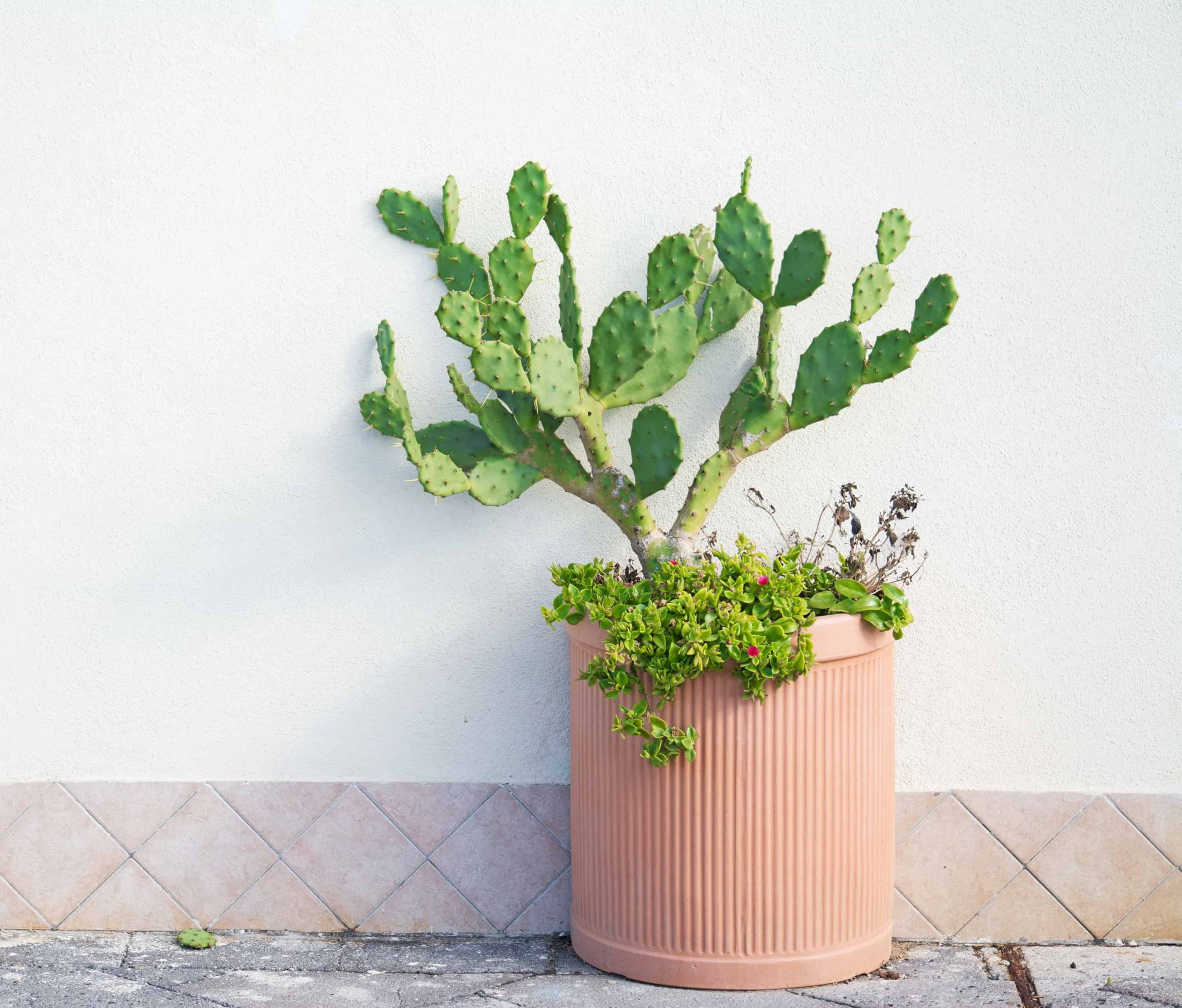
This cactus resembles a tree and often grows up to 40 feet long. It has short branches and bears pink, yellow, and red flowers. It is perennial and grows in any kind of well-draining soil.
-
Flaming Katy

Native to and found abundantly in Madagascar, the Flaming Katy has bright, vivid flowers and is a common choice for a houseplant. When growing it indoors, it’s preferable to use a clay pot with holes to allow air circulation.
-
Button Cactus

Found in the USA and Mexico, the Button Cactus is small, globe-shaped, and gray in color. They mostly grow in groups and are rough to touch. They bear pink flowers and resemble buttons, hence their name.
-
Cabega
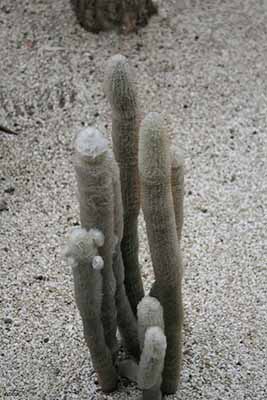
This is a common night-blooming species that grows in Brazil and Eastern and Northern Bahia. The cactus is long and tubular, growing bell-shaped white flowers. However, it is quite difficult to grow as a houseplant and is best grown outdoors.
-
Strawberry Hedgehog

The plant gets its name from its dark purple and yellow spines, giving it a distinct appeal. When mature, it can grow up to 24 inches but requires full, constant sunlight during the day to thrive.
-
Candelabra

Another cactus that can tolerate drought and requires full sunlight to grow, this plant is native to Mexico – Baja California. It doesn’t have a very long lifespan and can occasionally be grown in pots.
-
Carmine Cob

A small species of cacti grows only 6 inches when fully mature. The plant has brightly colored flowers and can be grown as a houseplant - if taken care of well. Due to its popularity, the plant is called a lot of names.
-
Catclaws

Originating in the USA and Mexico, this cactus species is a solitary plant and grows only 6 inches in height. It has a distinctive appearance with long, cylindrical ‘claws’ and dark red, pink, black, or brownish purple blooms.
-
Dwarf Chin

Found in Argentina, this cactus species are also solitary and has beautiful, large blooms typically red, orange, pink or white in color. It is also called the Spider Cactus and has long, radial spines which are quite sharp.
-
Linkleaf

Typically, the Linkleaf cactus can grow up to 18 to 24 inches in height. It is commonly known as the Christmas Cactus due to its bright pink or red flowers and is a long-living plant. It requires moderate moisture to grow but thrives in warmer climates.
-
Claret Cup Hedgehog

Found in several locations such as Nevada, Arizona, Mexico, Utah, and California, this cactus is typically known as a mounding cactus. It can grow up to 24 inches in height and forms bulbous piles which grow on top of or around each other. They may or may not have spines.
-
Cleistocactus

Native to Bolivia and Argentina, this species of cactus can grow up to 48 inches tall! It bears vivid emerald green and red flowers and has distinct short, dark spines.
-
Mistletoe Cactus

As sweet as the name sounds, the Mistletoe Cactus is long, cylindrical, and woody. It requires moderate amounts of water to thrive and generally bears white flowers. The cacti species is easy to grow in containers.
-
Saguaro opuntia

Originating from Haiti, this cactus has very few spines, or sometimes even none at all. It is typically known for its large size, growing up to 96 inches in height. It has long, dark green glossy arms with red blooms.
-
Old Man Opuntia

This cactus gets its name from its distinctive look - long, furry white branches. They don’t grow too tall, remaining 11 inches when mature but have purple-pink flowers.
-
Creeping Devil

Hands down one of the strangest looking cacti in nature, this plant grows horizontally and takes roots, sometimes disattaching from the parent plant altogether. The branches look white and furry and even have white blooms.
-
Crinkle-Leaf Plant

Also known as the Adromischus Cristatus, this cactus has thick triangular leaves with crinkled edges - hence its name. Although slow-growing, they are quick to propagate.
-
Calico Hearts

Native to South Africa, these cacti have paddle-shaped branches growing in clusters. They are gray-green with darker edges and sometimes sport purple spots. They are known for their pretty white, yellow, and pale green blooms.
-
Topsy Turvy

Also called Echeveria ‘Silver Spoons', this cactus has a ‘cabbage-like’ appearance with long leaves forming a rosette shape. Each ‘leaf’ rolls under itself while its tip flicks back inward, forming the unique rosette shape. It has gray-blue leaves with a wavy texture.
-
Bear’s Paw

This plant can grow up to 20 inches tall in the right conditions. It has oval-shaped swollen leaves covered with tiny hairs. The ripped edges give them a ‘claw-like’ appearance, hence the name. They are known for their star-shaped yellow, orange, and peach flowers.
-
Calico Cactus

A long, columnar cactus that grows anywhere between 6 inches to 24 inches when fully mature. It bears bright, beautiful pink blooms and is evergreen.
-
Cabega

Although this cactus can be grown in a container, typically they reach heights of 42 to 144 inches. It bears white flowers and has no branches.
-
Branched Pencil Cholla

As the name suggests, this cactus has long, pencil-like spines and several branches. It requires full sunlight to grow and reaches 72 inches in height.
-
Candy Barrel Cactus

A rounded cactus plant that tolerates drought and is easy to grow. It bears multiple beautiful yellow flowers and can grow up to 36 inches.
-
Aylostera narvaecensis

This houseplant is best known for its large, showy flowers that are typically pink in color. It can be grown in a container and requires full sun and partial shade to thrive.
-
Austrocylindropuntia shaferi

A medium-sized cactus that has distinctive upward-turning fingers, resembling chilies. This cactus makes a good houseplant and bears bright red blooms. It can reach anywhere between 6 inches to 18 inches when fully mature.
-
Austrocylindropuntia exaltata

This plant looks like a mix between the bunny ear cactus and the branched pencil cactus. It has distinctive bunny ear-like branches which are punctuated with long, pale yellow pencil-like spines. It blooms beautiful red flowers.
-
Astrophytum coahuilense

Best known for its showy, yellow flowers, this cactus has a distinct appearance with its round structure, pin-head-like bumps, and a very symmetrical shape. It is typically pale yellow in color with patches of dark green. It looks slightly similar to the Bishop’s Cap cactus.
-
Arthrocereus rondonianus

A typically elongated cactus plant that can grow up to 24 inches in height, this plant has thin, long white, or pale yellow spines throughout its body. It also has pink, distinct blooms and can be grown in a container. Its crown is generally filled with a cluster of spines.
-
Arrojadoa theunisseniana

Although its body looks similar to the previous cactus, its flowers have a peculiar pink, jelly-like appearance. Once the flowers mature, they turn deep black. These cacti are known for attracting birds due to their bright, jelly-like flowers.
- Arrojadoa penicillata

Again similar to the previous cactus on the list, this cactus also has distinctive pink and purple jelly-like blooms. Once the blooms begin to mature, they turn darker in color till they are completely black. They make great houseplants but may grow up to 48 inches.
-
Armatocereus oligogonus

This type of cacti grows in clusters and can reach heights of 36 inches to 48 inches. They have large, showy flowers and don't require much water to thrive. However, they do need adequate sunlight and dry soil. They typically don't have thin, long spines but do have spines.
-
Ariocarpus kotschoubeyanus subsp. Elephantidens

Even though this cactus has a long, complicated name, its appearance is rather small and stout. It grows only about 1 to 6 inches in height and makes a wonderful houseplant. Moreover, it has beautiful pink and purple blooms.
-
Ariocarpus confusus

With a name that sounds confusing, this cactus is well-known for its large, bright magenta flowers. Its body also has a distinctive shape and structure, with upward-turning leaves and a stout aloe vera-like appearance. They typically don't have spines.
-
Acanthocalycium thionanthum

This cactus is typically flat or rounded and quite small. However, it has large, dark red or maroon spines all over its body. Some of them may also have white or pale yellow spines which point downwards. It blooms yellow, orange, red, and pink flowers.
-
Acanthocalycium glaucum

Flat-bodied cacti with oval-shaped leaves, this plant doesn’t have spines but instead has red, protruding bumps all over its body. Furthermore, it bears some of the most spectacular red, peach, and golden blooms. It’s a great option for a houseplant and grows up to 6 inches.
-
Cleistocactus

Although this cactus is very similar to other elongated, columnar cacti, the Cleistocactus has a unique feature that sets it apart. This cactus often grows long, wavy, finger-like branches which are typically red in color. They have pale yellow spikes and the plant can grow up to 48 inches.
-
Common Fishhook Cactus

Here’s another cactus that is easy to grow and can tolerate droughts. It reaches a maximum of 12 inches in length when fully mature, and bears red flowers.
-
Compass Barrel Cactus

This cactus is rounded and flattish in shape, but its entire body is covered in red, curling spines. In fact, it has a distinct appearance of a woven basket. It blooms yellow flowers and can grow up to 96 inches when mature.
-
Copiapoa Humilis

An extremely unique-looking cactus - this species has large, geometric-shaped formations clumping to form a rock-like structure. It has 4-5 long, white spikes poking out of the middle of each formation. On its crown, it bears large, yellow flowers.
-
Corynopuntia Invicta

An evergreen cactus that can tolerate droughts and typically grows from 8 to 20 inches when mature. It brandishes long, thin, white spokes which look almost like sharp wires. The spikes are clustered but spread all over the cactus’s body.
-
Costa Rica night-blooming cactus

The most distinct feature of this cactus is that it grows vertically in long, flattish structures against trees. The cactus blooms white flowers but has a large, red, heavy onion-shaped structure. It is edible and attracts birds and butterflies.
-
Cotton Pole

As the name suggests, this cactus is covered with hairy, white, cotton-like wisps. It blooms pink and purple flowers and makes a good houseplant. Its leaves grow upwards like roots and are typically light green.
-
Dutchman's Pipe Cactus

This cactus resembles the aloe vera succulent’s long, thin leaves. However, its defining feature is its large white blooms which attract birds and butterflies. This plant can grow from 96 inches to 120 inches in height.
-
Echinopsis

A cactus that can grow up to 96 inches when fully mature - this plant is best known for its large, showy flowers. It has white, pink, and yellow blooms with a distinct appearance. The cacti are rounded and have symmetrically placed spines.
-
Electrode Cactus

Distinctly shaped with bright yellowish-orange spines and yellow flowers, this cactus is easy to grow in a container and can tolerate droughts well. The plants can grow anywhere from 18 inches to 48 inches in height.
-
Engelmann Prickly Pear

An attractive, shapely cactus that has large, flat leaves and long yellow spikes. This cactus is also easy to grow and drought-resistant. It can grow up to 72 inches in height and requires full sunlight and partial shade to thrive.
-
Eve's Needle Cactus

These cacti have swollen, long tubers with scaly flesh that looks similar to a pineapple or a flower. At full maturity, it can grow up to 180 inches in height. It blooms bright red, small-sized flowers.
-
Ferocactus Schwarzii

This cactus has an extremely distinctive and appealing appearance. It grows up to 24 inches and has very symmetrical petals, similar to a molecular structure. With yellow blooms and whitish-yellow spines, it looks different from other cacti.
-
Giant Barrel Cactus

As the name suggests, this cactus resembles a giant barrel. It is green with bright yellowish-orange spikes and can grow up to 72 inches. The plant looks similar to jackfruit.
-
Giant Chin Cactus

This small to medium-sized cactus grows only about 12 to 36 inches in height. It has a swollen, longish structure and very long, outward curling spikes. Typically, it bears white and pink flowers.
-
Goat’s Horn Cactus

Similar to the Giant Chin Cactus, this plant can grow up to 48 inches. With yellow-colored showy flowers and spikes which are longer than its body, this cactus has a unique appearance.
-
Gods Horn Cactus

Another species of cacti is similar to the previous two, this one has longer, wiry, and curved spikes all over its body. This plant also bears yellow, showy flowers.
-
Golden Barrel Cactus

A beautiful, symmetrically-shaped cactus with pale yellow spikes all over its rounded body. It requires full sunlight to grow and reaches a height of 36 inches at maturity.
-
Golden Cholla

Due to its numerous pale yellow spikes, this cacti has a golden appearance. It can grow up to 48 inches in height and has a rounded, ball-like longitudinal body.
-
Golden Rat Tail

A peculiar-looking cactus, this plant grows in long, hanging ‘tail-like’ structures. Like the previous one, it has deep yellow spikes all over, giving it a golden hue. It has coral, salmon, and orange-colored blooms.
-
Green Strawberry Hedgehog Cactus

This medium-sized cactus grows only up to 24 inches at full maturity. It has showy purple-pink blooms and can tolerate droughts. Its body is covered with large, sharp spikes.
-
Gymnocalycium

A small-sized cactus that grows well in containers. This plant can grow only 6 inches in height and has a rounded, swollen, purple-green hue. It blooms cream-colored flowers.
-
Gymnocalycium Friedrichii

This cactus grows only 9 to 11 inches in height. Each plant has a bright, yellow crown with spikes. It grows solidarily but numerously in one container.
-
Hairy Stemmed Rhipsalis

As the name suggests, this cacti have small, soft-looking spikes which resemble hair. They grow like twigs but are green in color.
-
Hooker's Orchid Cactus

With beautiful white blooms and a peach-pink core and stems, this cactus is a stunner. It grows up to 48 inches in full maturity and can tolerate drought conditions.
-
Horse Crippler

This cacti grow only up to 12 inches and has a rounded, dome-like structure. It has thick, orange-yellow spikes which are star-shaped. The cactus has white, purple, and pink blooms.
-
Johnson's beehive cactus

A cacti which can be easily grown in a container - this plant has an egg-shaped structure and is covered with red, lacy spikes throughout. It eerily resembles a beehive due to its spike formation.
-
Jumping Cholla

Growing up to 72 inches in height, this cacti bears yellow blooms and is covered with pale yellow spikes. Its structure resembles a tree - with awkward growing branches and spikes.
-
Echinopsis Formosa

Also known as Koko, this cacti has beautiful orange and red blooms and reddish-yellow spikes. It grows up to 72 inches and can tolerate droughts.
-
Little Nipple Cactus

A small-sized cactus that grows only 6 inches in height. This plant has bright pink blooms which look astonishing against its pale-yellow and green dome-like structure. It has long, dark sharp spines.
-
Ariocarpus Fissuratus

Looking similar to a thick, aloe plant, this cacti resembles a rock. It grows only 6 inches and bears pink blooms. It often has flesh-colored, thick, tongue-like branches and white, webbed structures.
-
Ariocarpus retusus

Similar to the previous cactus, this one has aesthetic, pale green leaves like an aloe. However, it blooms pink and white flowers and has an overall spiky appearance.
-
Mammillaria Dixanthocentron

This cactus also grows only 6 inches but has beautiful purple blooms. It is egg-shaped and has symmetrical, outward-growing small spikes covering its entire structure. The spikes are pale-yellowish in color and give the cacti their distinctive look.
-
Mammillaria Formosa

A cactus that looks like a hairy, white pineapple, this plant has a unique appearance. It is covered with short spikes and white web-like structures. It has a pineapple shape and grows up to 12 inches.
-
Mammillaria Grusonii

Also growing only 12 inches in height, these cacti grow close together and resemble small to medium-sized balls. They all are rounded and covered in small, yellow spikes.
-
Mammillaria Haageana

Growing only 2 to 9 inches in height, this small-sized cactus has a rounded structure and grows on top of each other. It bears beautiful pink flowers and is covered with the same web-like structures.
-
Lacespine Pincushion Cactus

As the name suggests, this cacti has lace-like spines all over its rounded body. It bears pale pink and peach flowers which look attractive. They grow only up to 6 inches in height.
-
Mammillaria Perezdelarosae

Typically growing from 6 to 12 inches in height, this cactus has white flowers and grows well in containers. It has an inverted egg structure and is covered with small, white spikes and longer ones in the middle with an orange tip.
-
Matucana Aureiflora

This cactus gets its name from its large, yellow showy flowers. It is easy to grow in a container and measures about 6 to 12 inches in full maturity. It thrives in full sunlight.
-
Matucana Madisoniorum

A uniquely shaped cactus that has a round, barrel-like appearance and sparse but long spines growing in sets of two. The spines grow outward like whiskers. This cactus bears large, showy red flowers on its crown.
-
Melocactus Bahiensis

Similar to the previous cacti, this one has multiple, long spines which look outward from a central point. They look like flowers but are quite sharp. On its crown, we see a white ball with red, hairy spines.
-
Melocactus Ernestii

With a dome-like structure, this cactus looks similar to its previous two but has sparsely spread spines. It has the same white formation with red, hairy structures on its crown.
-
Melocactus Zehntneri

This bunch of cacti looks like a large set of the previous family of cacti. They come in clusters but have various shapes and sizes, but the same red, hairy crowns.
-
Mexican Fire Barrel

A large-sized cactus that can grow anywhere from 96 inches to 120 inches at full maturity. Because of its red, yellow, and orange spines, it looks like it is on fire, hence the name.
-
Mexican Giant Cardon

Another large-sized cactus can grow up to 240 inches in height. This cacti has a long, cylindrical appearance and is covered with sharp white spines. It bears white blooms.
-
Missouri Foxtail Cactus

This cactus grows up to 12 inches in height and has bright, large, pink flowers on its crown. It grows well in containers and can tolerate drought.
-
Astrophytum myriostigma nudum

Also known as Mitra, this cacti don’t have spines but have white formations at regular intervals. It has a thick, star-shaped structure and looks like a big rock.
-
Old Lady Cactus

Due to its big, round structure and hairy, white spines, this cacti resembles an old, grey-haired plant. This is where it gets its name from. However, it bears beautiful pink blooms.
-
Old Man of the Andes

One of the most peculiar-looking cacti, this plant has long, pale hair growing from its cylindrical structure. It can reach 120 inches in height.
-
Old Man of the Mountain

Similar to the previous cacti, this plant grows only up to 24 inches. It grows vertically in a cylindrical structure and has white, hairy formations.
-
Organ Pipe Cactus

A very large cactus growing up to 114 inches, this plant is shaped like a musical instrument. It is green and grows in clusters.
-
Paper Spine Cactus

Only reaching 12 inches, these cacti have a peculiar appearance. It has long, noodle-like pale structures coming out of its body and grows vertically in a cylindrical shape.
-
Parodia Warasii

Reaching 18 inches in total, this round-shaped cactus has pale spines all over its body. It bears small, yellow blooms.
-
Peanut Cactus

Known primarily for its large red flowers and free-growing, rope-like appearance, this cacti has tiny spines all over.
-
Lophophora Williamsii

Also known as Peyote, this cacti has a large, pregnant appearance and bears showy, pink, and peach flowers. It appears to have a smooth body with no spines.
-
Powder Puff Cactus

Due to its white, hairy appearance, this medium-sized cacti resembles a powder puff used by women.
-
Escobaria Vivipara

Also called Purple Pincushion. This cacti looks like its name suggests and bears pink and purple blooms.
-
Queen of the Night

Growing up to 180 inches, these cacti is known for its showy white and yellow flowers. It is fragrant and can grow in containers.
-
Rainbow Cactus

One of the most beautiful cacti. It has red and white small spines and is medium-sized with showy blooms.
-
Rebutia Albiflora

Only growing 9 inches in height, these cacti is rounded. It has white spines and showy white flowers.
-
Weingartia Neocumingii

Rounded in shape, bearing beautiful yellow blooms. This cactus has a particularly wavy-textured body and star-shaped spines.
-
Rebutia Albiflora

Known for its showy pink and white flowers, this cacti grow well in containers. It reaches a maximum of 6 inches in height.
-
Rebutia Heliosa

A small-sized cactus reaching just 9 inches at maturity, this plant has large, red, showy flowers and resembles a cluster of cucumbers.
-
Red Buttons Opuntia

This cactus is a distinctive appearance. It looks somewhat like a prickly pear cactus but grows smaller, rounded cacti in clusters. Due to the small, red blooms, it gets the name “red buttons.”
-
Red Torch Cactus

With several cucumber-shaped cacti growing together in clusters, this plant reaches 24 to 36 inches in height. However, it gets its name from the bright, red flowers on its crows, giving it a ‘red torch’ like appearance.
-
Rhipsalis Neves Armondii

This cactus has long stems and white, wiry spikes. It bears showy white flowers and can grow well in containers.
-
Saguaro

These giant cacti grow up to 480 inches in height, being one of the largest of its kind. It bears edible fruit and has creamy-white flowers.
-
Sand Dollar Cactus

A container-growing cactus, this one reaches just 6 inches in height at full maturity. It has a round shape with tiny white dots all over its body. The cacti bear showy yellow flowers.
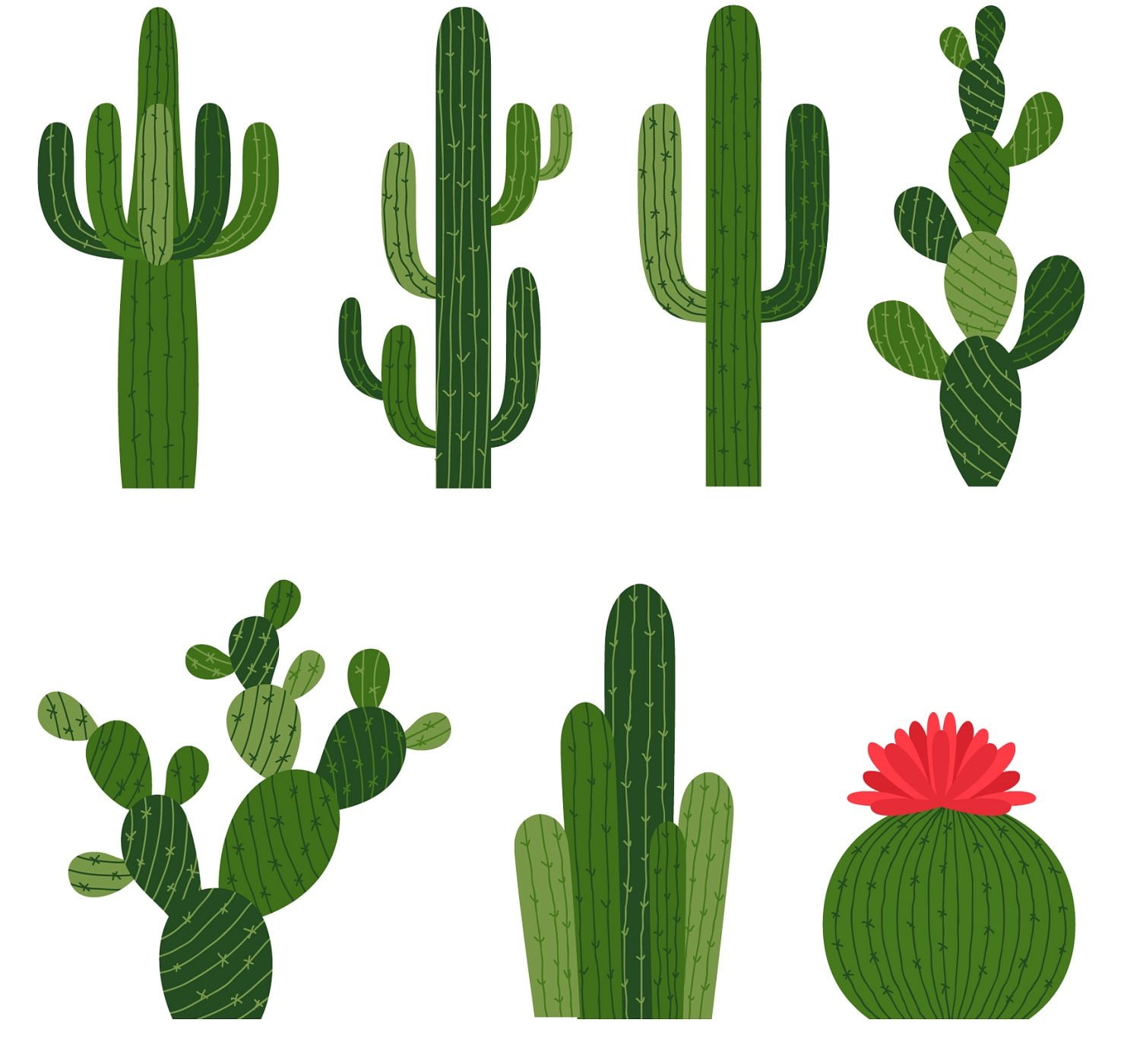
Final Words
After a lengthy, exhaustive list of 133 cacti, we’re exhausted! Of course, for someone who loves cacti, it will be a pleasure to go through this comprehensive list and look at the spectacular cacti we have compiled in it.
With that, we will take our leave. Let us know what your favorite ones are from our list!
Until next time!
